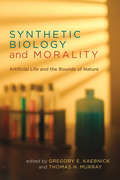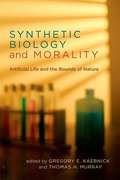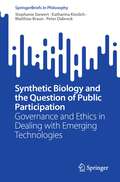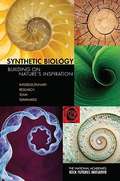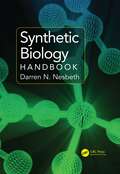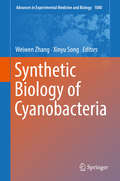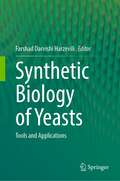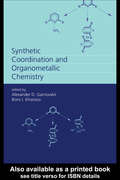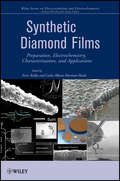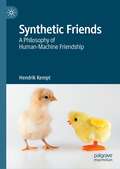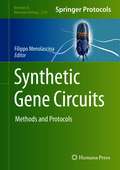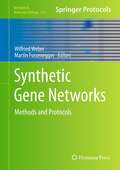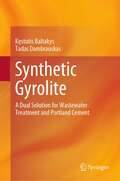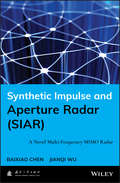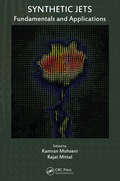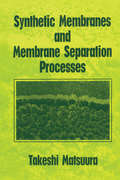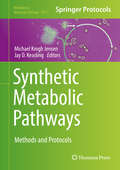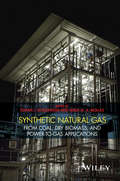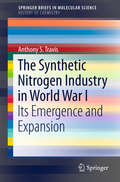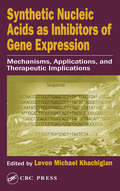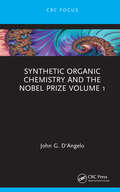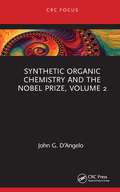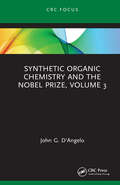- Table View
- List View
Synthetic Biology and Morality: Artificial Life and the Bounds of Nature (Basic Bioethics)
by Gregory E. Kaebnick Thomas H. MurrayA range of views on the morality of synthetic biology and its place in public policy and political discourse.Synthetic biology, which aims to design and build organisms that serve human needs, has potential applications that range from producing biofuels to programming human behavior. The emergence of this new form of biotechnology, however, raises a variety of ethical questions—first and foremost, whether synthetic biology is intrinsically troubling in moral terms. Is it an egregious example of scientists “playing God”? Synthetic Biology and Morality takes on this threshold ethical question, as well as others that follow, offering a range of philosophical and political perspectives on the power of synthetic biology.The contributors consider the basic question of the ethics of making new organisms, with essays that lay out the conceptual terrain and offer opposing views of the intrinsic moral concerns; discuss the possibility that synthetic organisms are inherently valuable; and address whether, and how, moral objections to synthetic biology could be relevant to policy making and political discourse. Variations of these questions have been raised before, in debates over other biotechnologies, but, as this book shows, they take on novel and illuminating form when considered in the context of synthetic biology.ContributorsJohn Basl, Mark A. Bedau, Joachim Boldt, John H. Evans, Bruce Jennings, Gregory E. Kaebnick, Ben Larson, Andrew Lustig, Jon Mandle, Thomas H. Murray, Christopher J. Preston, Ronald Sandler
Synthetic Biology and Morality: Artificial Life and the Bounds of Nature
by Gregory E. Kaebnick Thomas H. MurraySynthetic biology, which aims to design and build organisms that serve human needs, has potential applications that range from producing biofuels to programming human behavior. The emergence of this new form of biotechnology, however, raises a variety of ethical questions -- first and foremost, whether synthetic biology is intrinsically troubling in moral terms. Is it an egregious example of scientists "playing God"? "Synthetic Biology and Morality" takes on this threshold ethical question, as well as others that follow, offering a range of philosophical and political perspectives on the power of synthetic biology. The contributors consider the basic question of the ethics of making new organisms, with essays that lay out the conceptual terrain and offer opposing views of the intrinsic moral concerns; discuss the possibility that synthetic organisms are inherently valuable; and address whether, and how, moral objections to synthetic biology could be relevant to policy making and political discourse. Variations of these questions have been raised before, in debates over other biotechnologies, but, as this book shows, they take on novel and illuminating form when considered in the context of synthetic biology. ContributorsJohn Basl, Mark A. Bedau, Joachim Boldt, John H. Evans, Bruce Jennings, Gregory E. Kaebnick, Ben Larson, Andrew Lustig, Jon Mandle, Thomas H. Murray, Christopher J. Preston, Ronald Sandler
Synthetic Biology and the Question of Public Participation: Governance and Ethics in Dealing with Emerging Technologies (SpringerBriefs in Philosophy)
by Stephanie Siewert Katharina Kieslich Matthias Braun Peter DabrockThe book considers the relationship between governance and participation, and the ways participation has been understood, framed and applied in the context of synthetic biology (SB) governance approaches. Based on fundamental questions about the scope, purpose, and responsibilities assigned to public participation activities, the authors conducted an literature review of policy reports and articles on SB governance. The authors identify key characteristics of synthetic biology, such as the complex interplay of research, engineering and IT expertise in the field, as well as the challenges these characteristics pose in designing governance frameworks. Drawing on insights from a literature review, the authors contest calls for “earlier” and “more” participation on the basis that such calls fail to consider the necessary structural adjustments and resources needed for such endeavors. The brief addresses ethical questions arising in synthetic biology that could be used for developing frameworks of governance in the ongoing COVID-19 crisis and the consequent innovations in vaccine research.
Synthetic Biology Building on Nature's Inspiration: Interdisciplinary Research Team Summaries
by The National AcademiesSynthetic biology is an innovative and growing field that unites engineering and biology. It builds on the powerful research that came about as a result of a recombinant DNA technology and genome sequencing. By definition, synthetic biology is an interdisciplinary enterprise comprising biologists of many specialties, engineers, physicists, computer scientists and others. It promises a fundamentally deeper understanding of how living systems work and the capacity to recreate them for medicine, public health and the environment, including renewable energy. NAKFI Synthetic Biology: Building a Nation's Inspiration discusses new foundational technologies and tools required to make biology easier to engineer, considers ethical issues unique to synthetic biology, explores how synthetic biology can lead to an understanding of the principles underlying natural genetic circuits and debates how synthetic biology can be used to answer fundamental biological questions.
Synthetic Biology Handbook
by Darren N. NesbethThe Synthetic Biology Handbook explains the major goals of the field of synthetic biology and presents the technical details of the latest advances made in achieving those goals. Offering a comprehensive overview of the current areas of focus in synthetic biology, this handbook:Explores the standardisation of classic molecular bioscience approaches
Synthetic Biology of Cyanobacteria (Advances in Experimental Medicine and Biology #1080)
by Weiwen Zhang Xinyu SongThis volume highlights recent breakthroughs in the interdisciplinary areas of synthetic biology, metabolic engineering and bioprocess engineering for the production of green chemicals. It also presents practical experimental and computational tools for the design, construction and manipulation of cyanobacteria cell factories. The respective contributions cover new technologies in the field, such as novel genetic transformation techniques and bioinformatics analysis methods and address various aspects of cyanobacterial synthetic biology, offering a valuable resource for students and researchers in the fields of industry microbiology and biomedical engineering.
Synthetic Biology of Yeasts: Tools and Applications
by Farshad Darvishi HarzeviliThis book covers recent advances and future trends in yeast synthetic biology, providing readers with an overview of computational and engineering tools, and giving insight on important applications. Yeasts are one of the most attractive microbial cell factories for the production of a wide range of valuable products, including pharmaceuticals, nutraceuticals, cosmetics, agrochemicals and biofuels. Synthetic biology tools have been developed to improve the metabolic engineering of yeasts in a faster and more reliable manner. Today, these tools are used to make synthetic pathways and rewiring metabolism even more efficient, producing products at high titer, rate, and yield. Split into two parts, the book opens with an introduction to rational metabolic pathway prediction and design using computational tools and their applications for yeast systems and synthetic biology. Then, it focuses on the construction and assembly of standardized biobricks for synthetic pathway engineering in yeasts, yeast cell engineering and whole cell yeast-based biosensors. The second part covers applications of synthetic biology to produce diverse and attractive products by some well-known yeasts. Given its interdisciplinary scope, the book offers a valuable asset for students, researchers and engineers working in biotechnology, applied microbiology, metabolic engineer ing and synthetic biology.
Synthetic Chemistry of Stable Nitroxides (CRC Press Revivals)
by L. B. Volodarsky V.A. Reznikov V.I. OvcharenkoThis important book is devoted to covering the synthetic aspects of nitroxide chemistry. The problems of application and physicochemical properties of nitroxides are considered in the context of the choice of necessary radical structures, convenient precursors, and strategy of the synthesis. The book offers comparisons of the concrete classes of nitroxides to help reveal the structural peculiarities and synthetic abilities of compounds of different classes. It also summarizes data on the magneto-structural correlation for the metal complexes with 3-imidazoline nitroxides and considers the ways in which the molecular design of 2- and 3-dimensional heterospin compounds is capable of magnetic phase transfer in a ferromagnetic state. The book will be a significant reference for chemists, biochemists, spectroscopists, and other users of nitroxides, spin labels, probes, and paramagnetic ligands.
Synthetic Coordination and Organometallic Chemistry
by Boris I. Kharisov Alexander D. GarnovskiiThis reference describes standard and nonstandard coordination modes of ligands in complexes, the intricacies of polyhedron-programmed and regioselective synthesis, and the controlled creation of coordination compounds such as molecular and hn-p-complexes, chelates, and homo- and hetero-nuclear compounds. It offers a clear and concise review of mod
Synthetic Diamond Films
by Enric Brillas Carlos Alberto Martínez HuitleThe book gives an overview on the current development status of synthetic diamond films and their applications. Its initial part is devoted to discuss the different types of conductive diamond electrodes that have been synthesized, their preparation methods, and their chemical properties and characterization. The electrochemical properties of diamond films in different scientific areas, with special attention in electroanalysis, are further described. Different strategies to modify these electrodes are also discussed as important technologies with ability to change their electrochemical characteristics for a more specific electroanalytical use. The second part of the book deals with practical applications of diamond electrodes to the industry, organic electrosynthesis, electrochemical energy technology, and biotechnology. Special emphasis is made on the properties of these materials for the production of strong oxidizing species allowing the fast mineralization of organics and their use for water disinfection and decontamination. Recent biotechnological development on biosensors, microelectrodes, and nanostructured electrodes, as well as on neurochemistry, is also presented. The book will be written by a large number of internationally recognized experts and comprises 24 chapters describing the characteristics and theoretical fundaments of the different electrochemical uses and applications of synthetic diamond films.
Synthetic Friends: A Philosophy of Human-Machine Friendship
by Hendrik KemptThis book explores the notion of whether we can be friends with machines in a philosophically meaningful way. Depending on our concept of friendship, we may be inclined to answer differently. Since social technology has made new forms of friendships possible between people across the globe, the author argues that the philosophical concept of friendship, forged thousands of years ago, should be re-examined. The author proposes a new approach to the debate that reflects the unique relationship we can build with machines as our synthetic friends.
Synthetic Gene Circuits: Methods and Protocols (Methods in Molecular Biology #2229)
by Filippo MenolascinaThis volume provides clear and direct protocols to implement automated Design-Build-Test-Learn (DBTL) into synthetic biology research. Chapters detail techniques to model and simulate biological systems, redesign biological systems, setting up of an automated biolaboratory, step-by-step guide on how to perform computer aided design, RNA sequencing, microfluidics -using bacterial cell free extracts, live mammalian cells, computational and experimental procedures, metabolic burden, computational techniques to predict such burden from models, and how DNA parts can be engineered in mammalian cells to sense, and respond to, and intracellular signals in general. Written in the highly successful Methods in Molecular Biology series format, chapters include introductions to their respective topics, lists of the necessary materials and reagents, step-by-step, readily reproducible laboratory protocols, and tips on troubleshooting and avoiding known pitfalls. Authoritative and cutting-edge, Synthetic Gene Circuits: Methods and Protocols aims to ensure successful results in the further study of this vital field.
Synthetic Gene Networks
by Martin Fussenegger Wilfried WeberThe rapid expansion of synthetic biology is due to the design and construction of synthetic gene networks that have opened many new avenues in fundamental and applied research. Synthetic Gene Networks: Methods and Protocols provides the necessary information to design and construct synthetic gene networks in different host backgrounds. Divided into four convenient sections, this volume focuses on design concepts to devise synthetic gene networks and how mathematical models can be applied to the predictable engineering of desired network features. The volume continues by highlighting the construction and validation of biologic tools, describing strategies to optimize and streamline the host cell for optimized network performance, and covering how optimally designed gene networks can be implemented in a large variety of host cells ranging from bacteria over yeast and insect cells to plant and mammalian cell culture. Written in the successful Methods in Molecular BiologyTM series format, chapters include introductions to their respective topics, lists of the necessary materials and reagents, step-by-step, readily reproducible protocols, and notes on troubleshooting and avoiding known pitfalls. Authoritative and easily accessible, Synthetic Gene Networks: Methods and Protocols serves as an invaluable resource for established biologists, engineers, and computer scientists or novices just entering into the rapidly growing field of synthetic biology
Synthetic Gyrolite: A Dual Solution for Wastewater Treatment and Portland Cement
by Kęstutis Baltakys Tadas DambrauskasThis book explores the topic of gyrolite and calcium silicate hydrates, focusing on their potential applications in wastewater purification and as additives in ordinary Portland cement. Divided into five chapters, the book provides a comprehensive description of calcium silicate hydrates and addresses challenges in reusing solid waste. It also covers the synthesis and application of gyrolite, offering technological recommendations for future studies. The results presented are supported by instrumental analysis techniques and thermodynamic calculations, allowing readers to delve into inorganic chemistry and materials characterization. The book is suitable for both researchers and students interested in chemistry and materials characterization, offering valuable insights and guidance in the field.
Synthetic Impulse and Aperture Radar (SIAR): A Novel Multi-Frequency MIMO Radar
by Baixiao Chen Jianqi WuAnalyzes and discusses the operating principle, signal processing method, and experimental results of this advanced radar technology This book systematically discusses the operating principle, signal processing method, target measurement technology, and experimental results of a new kind of radar called synthetic impulse and aperture radar (SIAR). The purpose is to help readers acquire an insight into the concept and principle of the SIAR, to know its operation mode, signal processing method, the difference between the traditional radar and itself, the designing ideals, and the developing method. It includes 10 chapters. Chapter 1 gives an introduction to the basic principle of SIAR and its characteristic of four antis. Chapter 2 introduces the operating principles and system constitution of SIAR. Chapter 3 presents the main waveforms and the corresponding signal processing methods. Chapter 4 is about the long-time integration technique. Chapter 5 shows the high-accuracy measurement and tracking of 4D parameters of target in SIAR. The range-angle coupling and decoupling are introduced in Chapter 6, where a criteria for transmit frequency optimization of array elements is studied to overcome the coupling among range, azimuth and elevation. In Chapter 7, detection and tracking of targets in strong interference background is investigated. Chapter 8 analyzes quantitatively the influence of array error on the tracking accuracy of SIAR. Expansion of impulse and aperture synthesis to HF band and microwave band are introduced respectively in Chapter 9 and Chapter 10. The operating principle of the novel bi-static surface wave radar system, as well as the experimental system and the experimental results are included in Chapter 9. Written by a highly experienced author with extensive knowledge of SIAR (Chen), the book can be used as a reference for engineering technical personnel and scientific research personnel working in the research of SIAR, MIMO radar, digital radar or other new type of radar. It can also be a reference for teachers and students in universities who engage in related professional work. Details the operating principle, signal processing method, target measurement technology, and experimental results of synthetic impulse and aperture radar (SIAR) Expands the technique of impulse and aperture synthesisfrom the VHF band to the HF band and the microwave band Written by a leading author with many years’ research and practical experience in sparse array SIAR, a typical MIMO radar Engineers, researchers and postgraduates working in radar engineering will find this an invaluable resource.
Synthetic Jets: Fundamentals and Applications
by Kamran Mohseni Rajat MittalCompiles Information from a Multitude of SourcesSynthetic jets have been used in numerous applications, and are part of an emergent field. Accumulating information from hundreds of journal articles and conference papers, Synthetic Jets: Fundamentals and Applications brings together in one book the fundamentals and applications of fluidic actuators.
Synthetic Membranes and Membrane Separation Processes
by Takeshi MatsuuraSynthetic Membranes and Membrane Separation Processes addresses both fundamental and practical aspects of the subject. Topics discussed in the book cover major industrial membrane separation processes, including reverse osmosis, ultrafiltration, microfiltration, membrane gas and vapor separation, and pervaporation. Membrane materials, membrane preparation, membrane structure, membrane transport, membrane module and separation design, and applications are discussed for each separation process. Many problem-solving examples are included to help readers understand the fundamental concepts of the theory behind the processes. The book will benefit practitioners and students in chemical engineering, environmental engineering, and materials science.
Synthetic Metabolic Pathways
by Michael Krogh Jensen Jay D. KeaslingThis volume outlines key steps associated with the design, building, and testing of synthetic metabolic pathways for optimal cell factory performance and robustness, and illustrates how data-driven learning from these steps can be used for rational cost-effective engineering of cell factories with improved performance. Chapters are divided into four sections focusing on the four steps of the iterative design-build-test-learn cycle related to modern cell factory engineering. Written in the highly successful Methods in Molecular Biology series format, chapters include introductions to their respective topics, lists of the necessary materials and reagents, step-by-step, readily reproducible laboratory protocols, and tips on troubleshooting and avoiding known pitfalls. Authoritative and practical, Synthetic Metabolic Pathways: Methods and Protocols aims to ensure successful results in the further study of this vital field.
Synthetic Methods for Biologically Active Molecules
by Elisabetta BrennaThis useful reference focuses on the currently available toolbox of bio-catalysed reductions of C=O, C=C and formal C=N bonds to show which transformations can be reliably used in manufacturing processes and which still require improvements. Following an introductory chapter, chapters 2-4 present the synthetic strategies that are currently available for the reduction of C=C and C=O bonds and for reductive amination, by means of whole-cell catalysts and isolated enzymes. Chapters 5-7 go on to describe the improvements achieved thus far, illustrating the current versatility of enzymes in organic synthesis. Chapters 8-12 present the improvements brought about by the optimization of reaction conditions, and the use of particular synthetic sequences. The final chapter describes practical applications of bio-reductions for the synthesis of active pharmaceutical ingredients. With its excellent and comprehensive overview, this book will be of great interest to those working in academia and industry. From the contents: * Development of Sustainable Biocatalyzed Reduction Processes for Organic Chemists * Reductases: From Natural Diversity to Biocatalysis and Emerging Enzymatic Activities. * Synthetic Strategies Based on C=C Bioreductions * Synthetic Strategies Based on C=O Bioreductions * Development of Novel Enzymes for the Improved Reduction of C=C Double Bonds * Development of Novel Enzymes for the Improved Reduction of C=O Double Bonds * Synthetic Applications of Aminotransferases * Strategies for Cofactor Regeneration in Biocatalyzed Reductions * Effects of Solvent System and Substrate Loading in Bioreduction * Perspectives in the Use of In-Situ Product Removal (ISPR) Techniques in Bioreductions * Multi-Enzymatic Cascade Reactions Based on Reduction Processes * Relevant Practical Applications of Bioreduction Processes in the Synthesis of Active Pharmaceutical Ingredients
Synthetic Natural Gas from Coal, Dry Biomass, and Power-to-Gas Applications
by Tilman J. Schildhauer Serge BiollazProvides an overview of the different pathways to produce Synthetic Natural Gas Covers technological, and economic aspects of this Synthetic Natural Gas Details the most popular technologies and state-of-the-art of SNG technologies while also covering recent and future research trends Covers the main process steps during conversion of coal and dry biomass to SNG: gasification, gas cleaning, methanation and gas upgrading Describes a number of novel processes for the production of SNG with their specific combination of process steps as well as the boundary conditions Covers important technical aspects of Power-to-Gas processes
The Synthetic Nitrogen Industry in World War I
by Anthony S. TravisThis concise brief describes how the demands of World War I, often referred to as the Chemists' War, led to the rapid emergence of a new key industry based on fixation of atmospheric nitrogen. Then, as now, nitrogen products, including nitric acid, and nitrates, were essential for both fertilizers and in the manufacture of modern explosives. During the first decade of the twentieth century, this stimulated research into and application of novel processes. This book illustrates how from late 1914 the relations and developments in the first modern military-industrial complex enabled the great capital expenditures and technological advances that accelerated massive expansion, particularly of the BASF Haber-Bosch high-pressure process, that determined the direction of the post-war chemical industry.
Synthetic Nucleic Acids as Inhibitors of Gene Expression: Mechanisms, Applications, and Therapeutic Implications
by Levon Michael KhachigianIn the post-genomic era we have, at our fingertips, an incredible array of genomic sequences from a multitude of complex organisms. There remains, however, the critical need to understand the precise roles individual genes play in complex biological milieu. Bringing together authoritative reviews by renowned international leaders, this book presents cutting-edge research on inhibitors of gene expression and nucleic acid-based drugs. With numerous charts, diagrams, and graphs, the book covers the subject from lab bench to cancer-related clinical trials, making it an up-to-date and critical resource. Coverage includes discussions of ribozyme subtypes, structure-function aspects, and therapeutic applications; DNAzymes, their various subtypes, kinetics and biochemistry, and applications in target validation. Lastly, the mechanisms and multiple therapeutic applications of double-stranded oligonucleotide decoys are described.
Synthetic Organic Chemistry and the Nobel Prize Volume 1 (Synthetic Organic Chemistry and the Nobel Prize)
by John G. D'AngeloThe Nobel Prize is science’s highest award, as is the case with non-science fields too, and it is therefore arguably the most internationally recognized award in the world. This unique set of volumes focuses on summarizing the Nobel Prize within organic chemistry, as well as the specializations within this specialty. Any reader researching the history of the field of organic chemistry will be interested in this work. Furthermore, it serves as an outstanding resource for providing a better understanding of the circumstances that led to these amazing discoveries and what has happened as a result, in the years since. An outstanding resource which enables readers to better understand the conditions that led to these Nobel Prize amazing discoveries To an extent the roots of organic chemistry have been forgotten or lost and this set of volumes bridges the gap Unique set of volumes, no other book publication in the field competes and only press releases announcing the prizes from recent years exist "More than any other branch of chemistry, organic chemists look to history, so the readers will certainly enjoy this compilation " Appeals to a diverse audience including upcoming as well as modern practicing chemists, and provides the historical context of these discoveries
Synthetic Organic Chemistry and the Nobel Prize, Volume 2 (Synthetic Organic Chemistry and the Nobel Prize)
by John G. D'AngeloThe Nobel Prize is the highest award in science, as is the case with nonscience fields too, and it is, therefore, arguably the most internationally recognized award in the world. This unique set of volumes focuses on summarizing the Nobel Prize within organic chemistry, as well as the specializations within this specialty. Any reader researching the history of the field of organic chemistry will be interested in this work. Furthermore, it serves as an outstanding resource for providing a better understanding of the circumstances that led to these amazing discoveries and what has happened as a result, in the years since.
Synthetic Organic Chemistry and the Nobel Prize, Volume 3 (Synthetic Organic Chemistry and the Nobel Prize)
by John G. D'AngeloThe Nobel Prize is the highest award in science, as is the case with nonscience fields too, and it is, therefore, arguably the most internationally recognized award in the world. This unique set of volumes focuses on summarizing the Nobel Prize within organic chemistry, as well as the specializations within this specialty. Any reader researching the history of the field of organic chemistry will be interested in this work. Furthermore, it serves as an outstanding resource for providing a better understanding of the circumstances that led to these amazing discoveries and what has happened as a result, in the years since.
